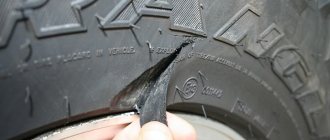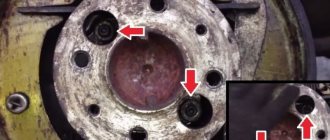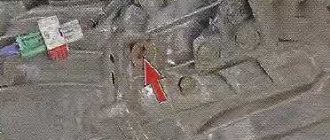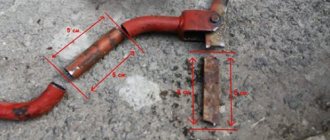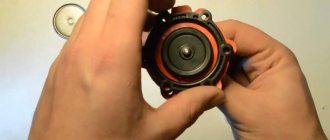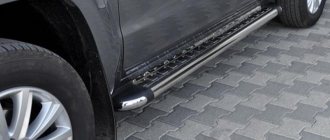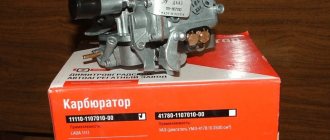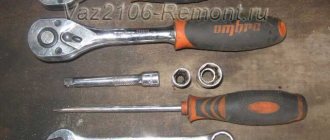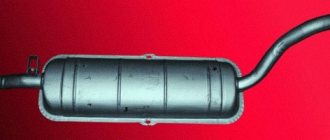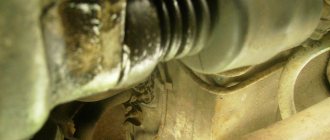The design of a car tire is quite complex. Even a beginner can handle tire puncture repair in the tread area. A side cut of the tire is a more complex damage. Not every car service center will undertake the repair of a side cut. So is it worth spending energy, time and money on repairs? And how to repair a wheel with your own hands?
Tire retreading
Repairs on the road
If the failure of tires is not associated with increased tire wear, then damage to tires on cars mainly occurs due to punctures and cuts.
Less commonly, due to manufacturing defects, a “hernia”—a swelling in the side of the tire—may form. Most often, car tire repair is done in special auto repair shops, which have a common name - “tire fitting”.
However, there are situations in which repairs are only possible with your own hands. This is especially true for drivers making long intercity trips.
This kit allows you to quickly repair tubeless tires on the track with your own hands, with the exception of a severe side cut or repair of a hernia on the wheel. In addition, the practice of operating cars over long distances suggests that when traveling intercity, especially in deserted areas, it is good to have one, or even better, two cameras of the required size.
There are situations when the kit does not save you and there is no other option but to re-flare the tires on your wheels yourself, installing tubes in them.
Tire repair
The technology for restoring car tires from a puncture or side cut in a tire shop has long been developed and can be done in different ways, among which the most famous are:
- express repair;
- one-step method with hot vulcanization of the patch;
- two-stage - with cold vulcanization of the plaster;
- repair of hot vulcanization chambers.
A tire cannot be repaired if:
- it has severe damage beyond acceptable parameters;
- cord threads are visible, and they are torn or otherwise deformed;
- there are cracks on the tread or side part up to the cord;
- There is noticeable wear on the side down to the cord.
You can repair a tire with your own hands; the technology for this process has also been proven.
Puncture or small cut - we repair it ourselves
In order to repair a puncture or side cut no larger than 3 mm, you need a special kit for repairing tubeless tires. If such a kit is not at hand, then you can get by with special glue and strands.
- Before you begin repairing a tire side cut or puncture, you must bleed the air from the wheel.
- Determine the location and nature of the cut or puncture and remove the foreign object from the hole.
Take an awl from the kit to prepare the hole. Apply glue from the same kit to it.
Rotating as the clock progresses, insert it into the puncture hole with a smooth movement.
- The tool must enter with force into a puncture or side cut of the tire. You also need to remove it by rotating in the same direction. Repeat entry and exit several times, ensuring that the glue covers the inner surface of the cut or puncture.
- Before installing the harnesses, leave the awl in the damaged area so that the glue is able to secure the harness well.
- Remove the protective film from the harness to the length required for routine repair of the tubeless tire. Place the end without film into the insertion awl, making a short end 20 mm long. Apply glue to the awl and the harness at the junction.
Rotating, pull the spiral awl out of the hole and, without allowing the walls to close, quickly insert a tourniquet lubricated with glue into it, not allowing the short end to fall into the hole. Its edge should be fixed at the level of the tread.
Yank the opening awl from the area being repaired and evaluate the tightness of the repaired damage. To do this, inflate the tire. After checking, cut off the long protruding end of the harness, leaving two millimeters above the tread.
As an illustration of the correct installation of the harness, you can consider this diagram:
Large tire cut on the side
To repair side cuts of tires, an extended kit is usually used, which contains various tools, patches, glue and various chemicals for treating the damaged area of the tire.
- If urgent temporary repair of damage is required, then repair of side cuts larger than six millimeters in an emergency situation can be done without a patch using several strands on which glue is generously applied.
- For major repairs, the wheel must be removed and the tires removed. Cut the edges of the damaged area with pliers, clean it with a drill and treat it with special cement.
Cut raw rubber into thin strips and stretch. Then place it inside the side cut of the tire.
The next step is vulcanization.
After vulcanization, markings are made for installing the patch, this area is cleaned, degreased and lubricated with cement from the repair kit.
After the cement has dried, a reinforced patch is applied, onto which glue is applied. The edges of the patch are treated with sealant.
The patch is pressed in a vice for 1–2 hours.
The cord on the tire is worn out, what should I do?
During the operation of a car, its wheels receive various damages - side cuts appear on the tires, tire deformation (the so-called hernia).
- 1 Causes of hernia on the wheel
- 2 Is it possible to drive with a hernia on a wheel?
- 3 What to do if there is a hernia on the wheel
- 4 How professional tire fitters fix a hernia
- 5 Rules for driver behavior when a hernia is detected on a wheel
- 6 Wheel selection
Motorists often ask if there is a lump on the wheel, what to do, and whether it is possible to operate the car with it. In this article we will try to deal with this issue, and at the same time we will advise how to eliminate the defect.
Causes of hernia on the wheel
A bump on the side surface of a tire is formed as a result of the destruction of the inner cord; automobile rubber itself is multilayer. A hernia (bump) on a tire can form for various reasons; the cord threads usually break:
- with a side cut of the tire;
- when a car falls into a deep road hole, when the vehicle is moving at a sufficiently high speed;
- as a result of abrasion of the tread, for example, on a curb;
- from a blow to the wheel, for example, when a car gets into an accident.
Is it possible to drive with a hernia on a wheel?
When the cord on a tire is damaged by an impact, the threads inside break and a bump appears on the wheel. Usually the lump on the wheel comes out from the side; it mainly forms on the outside. A hernia comes in different sizes, and if it is small, it may not even be noticed at first. If a bump has appeared on a car tire and increased in size, when the car is moving, a beating may be felt, which can be felt in the steering wheel.
Is it possible to drive with a bump on the wheel? It all depends on the size of the damage, but if you approach this issue strictly, it is extremely undesirable to operate a car with damaged tires, even if the defect is minor. The thing is that during the operation of the vehicle, the damaged area on the wheel progresses and increases in size, and in some cases the tire may explode, and the driver may get into an emergency. A tire with a lateral hernia bursts in the following cases:
- if the damaged wheel gets into the hole again;
- at high speed when driving on uneven roads;
- on a loaded car (for example, there are several passengers in the cabin and there is a heavy load in the trunk);
- at high speed;
- when you press the brake pedal sharply.
Manufacturers of car tires warn that the use of tires with any damage is prohibited, regardless of the degree of the defect.
The driver can feel the appearance of a bump on the tire by the first signs - there may not be an imbalance, but barely noticeable bumps begin to appear in the wheel, and the ride becomes uncomfortable. If the car owner nevertheless decides to continue to operate the car, he must regularly check the condition of the wheel and carry out an external inspection.
What to do if there is a hernia on the wheel
When a defect appears on a car tire in the form of a bump, theoretically the driver has three options:
- completely replace the wheel (install a spare tire);
- go to a tire repair shop to have the defect repaired;
- try to repair the tire yourself.
The third option is only theoretically possible, and then only if the driver himself is almost a professional tire fitter. The most reliable option is to change the entire wheel or install a new tire on the rim.
How professional tire fitters fix a hernia
Repairing a tire in a tire shop looks something like this:
- the wheel is removed and disassembled;
- the surface of the tire is thoroughly cleaned and degreased;
- a layer of material containing raw rubber is applied to the damaged area;
- a reinforced patch is installed on top of the damage;
- vulcanize the tire.
It is possible to remove a bump on a tire in this way, but it should be taken into account that the inner cord is still not completely restored, and the repaired area on the tire remains the most vulnerable spot. After repairing a tire, it must be balanced, but if the wheel cannot be balanced, it has to be scrapped.
To restore a tire using a vulcanizer, it must be left in a tire shop for a day, which is very inconvenient for the driver. Even when restoring a wheel with a hernia, you should take into account that such repairs are quite expensive, and in some cases they are comparable to the price of a new tire. You can understand the car owner - sometimes a hernia appears on almost new tires, and the driver regrets the money spent on the purchase. But road safety is no joke - it’s better to lose money than a car, your health or even your life.
How to determine whether a cut on a tire can be repaired
Despite its visual simplicity, the tire is a complex structure. A side cut is not always caused by a bump, hole, or asphalt reinforcement. Often tires are slashed by ill-wishers, neighbors in the parking lot.
- Well, if the cut runs along the tread of a tubeless tire, it can be repaired from the inside. Damage to the side slats can be repaired, but this requires skill. Violation of installation technology can harm the subsequent operation of the vehicle.
- Modern tires of radial design, bias-ply ones are de facto supplanted by competitors. Putting a piece of rubber on a metal disk and pumping it with air will not give a positive result. The rubber will burst under gravity.
- In order to strengthen the structure, several layers of metal cord - wire - are added. Foreign manufacturers use fabric cord made from nylon fibers. This design will withstand heavy loads.
- In the case of a side cut, the structure loses strength, the area becomes vulnerable, and the integrity of the cord is compromised. You can quickly seal it with a patch, but this is before the first hole. Once you hit a bump, the patch will fly off.
- Is there any point in restoring a damaged tire if the tread wear is over 70%. Obviously not. Although each owner decides for himself. Resuscitation of a tire will cost the same price as buying a used one on the market.
It’s a different matter when the tread pattern is complex, the brand is rare, or even a new tread that has not lasted even 1000 km.
How does a tire work?
The design of a modern tire is a rather complex system, within which there are two types of strength frame:
- Metal frame - made of the finest metal wire threads;
- Frame made of durable nylon threads.
There are 2 types of car tire products:
- radial - the cord threads do not intersect, they are located transversely from one side to the other;
- diagonal - cord threads are located diagonally from one side to the other, crossing in layers.
Currently, radial ones are being mass produced, and diagonal ones are fading into the background.
During the production of tires, the power frame made of metal and nylon is filled with a layer of rubber, which gives strength to the structure. The cord made of wire and threads is firmly held by a rubber layer, and the wheel can withstand heavy loads without bursting.
Why is a tire cut dangerous?
When cut on the side, the wires and cords are torn or cut, and the strength of the entire wheel is lost. Even when the cut is sealed, these threads are not restored. And any obstacle in the form of a hole or curb can lead to dire consequences. The wheel will simply burst from the load and the car will lose control.
A side puncture is not so dangerous, and after a quality repair it is quite possible to use such a wheel.
Types of side cuts
For radial tires, there are two main types of damage.
- Along the threads. In this case, they are practically undamaged, or only slightly caught. Such a cut can be repaired without much difficulty.
- Across the cord. The most difficult case. Often it is not possible to restore the integrity of the tire.
Sometimes combined injuries are also identified; they can combine a longitudinal and transverse incision. In such a situation, you need to decide whether repairs are worthwhile at all individually.
In general, there are requirements for cuts that can be repaired. We list the cases when restoration is impossible and a complete tire replacement is required.
- The damage is located less than 4 centimeters from the edge of the tire. Such a cut will certainly compromise the rigidity of the tire.
- The size of the longitudinal damage to a tubeless tire is more than 35 mm, while for rubber with a tube it is more than 45 mm.
- The transverse cut of a tubeless tire is longer than 25 millimeters, and for a tube tire it is more than 35 millimeters.
- On truck tires, they look at the number of damaged cords. If more than 10 threads are damaged, the tire cannot be restored.
In other cases, you can try to make repairs.
What types are there
They are divided into:
- horizontal;
- diagonal;
- vertical.
In some cases it can be doubled in the form of a diverging triangle. Vertical and diagonal types are considered beyond repair.
It is also worth paying attention to how the rubber is cut relative to the cord threads. If along them and the strength of the hull is not significantly compromised, the situation can really be corrected. When they are cut across, the gap is almost impossible to repair. To determine this, you need to know what type of tire you have - radial or diagonal.
In order to understand whether repair is possible, count the number of damaged threads. For example, for trucks there is a rule: if more than 10 pieces are torn, welding the cut on the side of the tire or patching it in any other way is prohibited. In this case, the rubber is sent for disposal, since it is dangerous to use.
Repair at a service station
The service station performs more complex and high-quality repairs. The sequence of work looks like this:
- Dismantle the wheel and assess the extent of damage.
- Level the edge of the damaged area using side cutters.
- Clean the surface and apply a special cement mixture.
- Raw rubber is cut into narrow strips, stretched and placed into the cut cavity.
- Rubber is vulcanized using special equipment.
- Clean the damaged area, degrease it and apply cement.
- After the cement has dried, glue the patch and treat its edges with sealant.
- Install the tire on the rim and balance the wheel using special equipment.
Do not subject the repaired tire to heavy loads - this can be dangerous. Use it in an emergency or as a spare tire to get you to the tire store or repair shop.
Is it possible to drive on a repaired tire with a side cut?
Even if you have sealed the tire. It is not worth using it in the previous mode. a damaged cord cannot withstand the same loads as before. This fact can lead to unpleasant consequences in the form of an accident.
If you decide to install a repaired tire on your vehicle, you must take precautions. It is not recommended to install tires after repair on the front axle, especially if it is a drive axle. Here the tires bear the maximum load. This may cause the rubber to deteriorate.
Also, if a wheel on the front axle explodes, the likelihood of losing control at speed is much higher. Always put the repaired wheel back.
But, it is best to use the repaired wheel only as a re-roller. And then, it is advisable to install a spare tire on the rear axle, and move a good wheel to the front axle if the tire from there is damaged.
Answering the question whether it is possible to drive on a repaired tire, it is worth saying that this is allowed. It is better to avoid such use. Nevertheless, the technical condition of the tire greatly affects the level of safety.
Restoring tires at home
One of the effective ways to eliminate cut tires is a method consisting of the following steps:
- The size of the cut is measured, if it is within the acceptable limits, you can begin to eliminate it.
- The edges of the cut are ground down with a special fine abrasive to give the damage a bowl shape.
- After treatment with an abrasive, the surface is degreased using gasoline or alcohol. The slot is then filled with raw rubber.
- A tire treated with this method is vulcanized. This process is performed using a special camera or a production hair dryer.
- After vulcanization, the rubber-filled cut is cleaned, a special reinforced patch is glued, and the wheel is balanced.
You can seal the tire in this way with your own hands without involving specialists. In this case, during operation of the repaired tires, wheel runout may occur. To use a sealed tire for a long time, it is better not to load the car and give preference to a measured driving style: increased loads on the wheel can lead to a tire rupture.
We recommend: Do-it-yourself auto electricians: repairs and practical recommendations from specialists.
Are tires repairable?
Particularly thrifty drivers, who are trying to save every penny and not spend extra money on their car, are interested in whether it is possible to restore tires if cracks form on them.
The answer to this question again depends on the specific circumstances.
There are masters who are ready to do whatever the client asks for money. At the same time, they are silent about the consequences that such repairs can lead to.
You should figure out what to do in such a situation and how you can treat your tires so that they do not crack further. It is worth giving several recommendations in this regard.
- It is almost impossible to remove deep damage. Yes, it is possible to remove defects cosmetically. But since the cracks are deep enough and can reach the cord, no adequate craftsman will undertake such work. He will not take responsibility for what will happen to the car and its driver if he again drives on retreaded tires.
- If the damage is minor, then repairs are allowed. To remove cracks, you will need to contact a tire shop. Here, using a special machine, defects will be repaired by melting rubber. But no one will give guarantees for long-term work after such a restoration. Therefore, everything here is completely under your responsibility and at your own discretion.
- When we are talking about small cracks and cobwebs that have not yet had time to disrupt the structure of the rubber itself, you should use special compounds. This is a silicone-based liquid or spray. They are positioned as a means to slow down the aging of rubber. They work pretty well. But it is better to use them even before the first cracks appear, purely for prevention and to extend the service life of the rubber set.
What does the rigidity of a tire structure affect?
The average air pressure in passenger car tires is 2 atmospheres. This means that for every square centimeter of a cut, air presses with a force of 2 kilograms. And the stronger the air presses on the cut, the more the area of the cut increases, because its edges diverge in different directions under pressure. Therefore, on a cut with a damage area of 10 square centimeters, air presses with a force of 20 kilograms. If you apply a regular patch made of vulcanized rubber, then there is a high probability of a “hernia” appearing, because the patch’s rigidity is not enough to resist air pressure and the rubber will squeeze out with a bubble. The danger of a “hernia” is that the thickness, and therefore the strength, of the rubber is reduced several times; this can lead to a blowout and a sharp drop in pressure in the tire. The result is a loss of controllability and, at best, being thrown to the side of the road.
Which cut can be repaired?
Repairing the tread and the side of the tire has a fundamental difference. The sidewall is 3-4 times thinner than the tread and experiences increased loads when moving. The density of the metal and fabric threads of the frame and their integrity are responsible for the reliability of the entire structure.
Side cuts are divided into longitudinal and transverse. A transverse tire cut of no more than 3 cm and a longitudinal cut of up to 5 cm are subject to repair; The cut is eliminated by vulcanization with gluing of a patch.
Longitudinal cut of a car tire Longitudinal cut of a tire
If the side damage is large or the cross-section is located closer than 4 cm to the edge, the tire is not repaired. Further operation is associated with great risk - the wheel may explode if it falls into a small hole, hits a cobblestone, etc.
Repair with sealant
You can seal a tubeless tube puncture or repair side cuts on your tires using an aerosol sealant. To do this, you need to jack up the wheel and pump sealant from a can into the nipple.
Spin the wheel several times so that the substance spreads throughout the inside of the tire. Remove the jack and drive three hundred meters. After this, check the tightness of the damaged tubeless tube.
We recommend watching videos on the topic:
Many motorists have encountered such an unpleasant situation as tire damage while driving. The tire could have deteriorated due to a foreign object caught under the wheels or due to excessive load. If you discover damage to a tubeless tire, do not rush to go to a service station; depending on the complexity of the puncture, you can fix it yourself.
Professional restoration
How are tire side cuts repaired in special auto repair shops? Tires repaired at auto repair shops last longer than tires sealed at home. A good result of repair work carried out by specialists is determined by the following factors:
- availability of special equipment, tools, high-quality consumables;
- special education and experience of masters.
In equipped workshops, the process of eliminating cuts on the side surface of tires consists of the following steps:
- The tire is dismantled and the dimensions of the slot are measured.
- The edges of the cut are trimmed to ensure quality boiling.
- Using a special drill, the surface requiring repair is cleaned.
- A special cementing agent is applied.
- Raw rubber is being cut. Thin rubber strips are placed in the slot previously prepared for gluing.
- The tire is vulcanized in a special chamber.
- After vulcanization, the damaged area is cleaned and markings are applied to install a reinforced patch.
- The prepared area can be degreased, then a special cementing agent is applied and after it dries, the patch is glued.
- The edges of the glued patch are treated with sealant.
- After the sealant has hardened, the tire is mounted on the wheel and balanced.
How to determine if a tire can be repaired
To reliably assess the consequences of tire deformation, before repairing the tire, contact a specialized center. The technicians will figure out whether it is possible to continue driving the car or whether it is worth replacing the tires. The main inspection criterion is the width of the seam that needs to be repaired. It is worth considering that it is dangerous to seal holes wider than 40 mm with rubber compounds.
If the craftsmen decide to restore the tire and make a patch, then the restoration process includes the following stages:
- dismantling a tire - before sealing the holes, specialists measure the diameter of the seam;
- trimming and grinding the edges of the hole - high-quality replacement of the blade requires reliable welding of the material;
- applying cementitious material and raw rubber, which allows you to make a reliable patch;
- vulcanization of the tire in a professional chamber, which allows you to reliably seal the rubber;
- applying a reinforced patch to the treated area;
- degreasing the surface and re-applying the cementitious composition;
- tire installation.
The decision to make a patch should be made by experienced specialists who can advise whether it is worth sealing the seam or whether it is necessary to replace the tires. Restoration of rubber, despite the observance of technology, cannot restore the original properties of the frame, so you should ride on such tires carefully.
It is also worth considering that if you are restoring a tire, you must break it in before active use. To avoid negative consequences, we do not recommend driving at high speeds.
Use the sealed tire again or replace with a new one
Is it possible to drive: both “yes” and “no”, consider a number of the following factors:
- Vehicle drive type: Front-wheel drive has most of the weight located in front, in the engine compartment. A tire burst at speed will significantly reduce controllability, and an emergency situation is possible. With rear-wheel drive, the main weight is located at the rear. A tire burst is no less dangerous, but the chances of maintaining control are greater;
- Tread depth: if actual wear is less than 45 - 50%, then continue to use the tire. Otherwise, replace with a new one;
- Speed limits: It is not recommended to operate vulcanized rubber at speeds above 100 km/h. Management becomes unsafe;
- The presence of other cuts, rations, patches: the more cuts, the weaker the tire structure. Experienced service station technicians strongly recommend not using a tire if it has two or more cuts.
Professional restoration
How are tire side cuts repaired in special auto repair shops? Tires repaired at auto repair shops last longer than tires sealed at home. A good result of repair work carried out by specialists is determined by the following factors:
- availability of special equipment, tools, high-quality consumables;
- special education and experience of masters.
In equipped workshops, the process of eliminating cuts on the side surface of tires consists of the following steps:
- The tire is dismantled and the dimensions of the slot are measured.
- The edges of the cut are trimmed to ensure quality boiling.
- Using a special drill, the surface requiring repair is cleaned.
- A special cementing agent is applied.
- Raw rubber is being cut. Thin rubber strips are placed in the slot previously prepared for gluing.
- The tire is vulcanized in a special chamber.
- After vulcanization, the damaged area is cleaned and markings are applied to install a reinforced patch.
- The prepared area can be degreased, then a special cementing agent is applied and after it dries, the patch is glued.
- The edges of the glued patch are treated with sealant.
- After the sealant has hardened, the tire is mounted on the wheel and balanced.
Recovery
After the check is completed, it’s time for the most important process, which is called roughening. The master installs the tire on a roughening machine, with the help of which the remnants of the old “frame” are removed, and the tire is given the correct shape. After completing this stage, you can begin vulcanization. Damage can be removed using tire repair adhesive suitable for cold vulcanization.
Purpose of tires by type of road surface
Based on the road surface, tires are divided into:
- road;
- off-road;
- universal;
- winter.
Often, road and winter ones are classified as the same type, but we will look at them separately. Technically they are somewhat different.
Road tires usually have a classic tread and are designed for road use. All the main differences between tires of this type are the features of the tread, as well as the ability to maintain control over the car on wet asphalt. They are distinguished by a straight pattern with virtually no lamellas.
Off-road vehicles are designed for use on any surface. Thanks to the large tread, sipes and other features, such tires allow you to drive effectively on any surface without fear of problems.
Universal tires combine the qualities of road and off-road tires. But, according to many experts, they are inferior to specialized tires.
Prices for tire puncture repair
| RADIUS | PUNCTURE REPAIR | REMOVE PUT | MONTAGE DEMONTAGE |
| R-14 | 1100 RUB. | 200 RUB. | 200 RUB. |
| R-15 | 1100 RUB. | 200 RUB. | 200 RUB. |
| R-16 | 1300 RUB. | 350 RUB. | 350 RUB. |
| R-17 | 1300 RUB. | 350 RUB. | 350 RUB. |
| R-18 | 1500 RUB. | 400 RUB. | 400 RUB. |
| R-19 | 1500 RUB. | 400 RUB. | 400 RUB. |
| R-20 | 1700 RUB. | 450 RUB. | 450 RUB. |
| R-21 | 1800 RUB. | 450 RUB. | 450 RUB. |
| R-22 | 2000 RUB. | 500 RUB. | 500 RUB. |
The most common cause of a tire puncture is running into a screw, nail or other sharp object on the road surface. Wheels can also be damaged by slab reinforcement or curbs. Often, screws and nails remain in the tread, which makes it much easier to find the location of the damage. It is not recommended to remove foreign objects from the rubber yourself. Because In this case, you risk completely ruining the wheel.
Urgent repair of tire punctures is one of the main activities of the FastAvtoservis mobile tire fitting service. Our company’s specialists will quickly arrive at the specified point in Moscow and the region, find the puncture site and return the wheel to working condition.
External device
If we consider the structure of a car tire only from the outside, then it consists of:
- sides;
- sidewalls;
- shoulders;
- treadmill.
The beads ensure a secure fit of the tire on the rim. The rigidity of these elements is provided by power rings made of metal wire, fused into the frame around the circumference. When looking at the cross section of a tire, the beads are the peaks in a C-shape.
The sidewalls extend from the sides - the side parts of the frame, coated with an additional protective layer of rubber that prevents damage to the cord frame.
The shoulders provide the transition from the sidewalls to the treadmill. In addition, when deformed (when hitting an obstacle, entering a turn), the shoulders take part in providing traction with the road.
The treadmill, which is the main working surface, approaches the shoulders, so it has the most multi-layered structure.
In cross-section, the tire structure is as follows: there are two beads connected to two sidewalls, which go to the shoulders, and those go to the edges of one treadmill, which forms a C-shape.
Side cut repair
What to do with such damage? A side cut is either repaired manually or at a service station where there is a tire repair service. At a tire repair shop, they will do everything for you and without your participation, so there is no point in telling the process. But knowledge of repairs in the field will definitely be useful to you, so stock up on a kit for such a procedure. The repair procedure and methods are also suitable for truck tires, only here damage to no more than 10 cord threads is allowed; if more than 10 cord threads of a truck wheel are damaged, there is no point in repairing it.
To seal a side cut there are the following methods:
Heating method
This is a do-it-yourself repair in the field, which is not always possible, since you also need a heating hair dryer powered by a battery, or another heater (soldering iron, etc.) that can be powered by a battery. You can actually make a fire and heat a metal object on it, which you can then use as a soldering iron. This type of repair is called hot vulcanization. When heated, raw rubber boils and swells like lava from an erupting volcano. After warming up, it hardens, like lava.
Instead of a soldering iron, small gas cylinders are now sold; they are also convenient for heating something in the field. Therefore, along with the vulcanization kit, have such a can. A tire with a side cut is cooked in the following sequence:
The tire will have to be removed and disassembled. Clean the damaged area with sandpaper and degrease with gasoline. After this, fill the slot with raw rubber from the repair kit. Cover the damage on both sides with film and heat it to brew using a heating device. After the patch has hardened, you need to assemble the wheel and inflate it; if the air does not leak, you can put it back and drive carefully. Manual vulcanization takes 1-2 hours.
Gluing the patch
This type of DIY tubeless tire repair does not require heating devices. Tire patches should be included in the repair kit; special glue is also sold with them. Along with the repair kit, you need to carry a clamp, with which the patches are pressed tightly on both sides. To carry out repairs, the wheel will also have to be removed and disassembled. The surface around the cut should be cleaned with sandpaper and then degreased; gasoline is suitable for this purpose.
How to make suitable patches - the patches are cut to a size 2-3 millimeters wider than the slot. Then you need to apply glue and press the patch firmly. The patches are pressed for 1-2 hours; if there is no clamp, you will have to glue them one at a time, pressing them with a heavy object. After assembling and inflating the wheel, if there is no air leakage, then you can hit the road.
For a tubeless tire, there is another option, how to repair a small hole with your own hands. Stores sell kits with a rubber band, an awl and a metal wrench for repairing holes. If there is a relatively small breakdown along the way, you can perform the following actions. The detected damage is expanded with an awl, then we take out the tourniquet and attach it to the knob. Then, using a wrench, push the tourniquet into the punched hole on the outside of the tire. There should be a loop inside the tire, with a diameter larger than the puncture hole. The outside of the harness on the tread is cut with a knife. Is it possible to repair a large cut this way? No, this method will not work for cuts larger than the diameter of the tourniquet. After inflating, return the wheel back.
The main thing is to know that the structure of a punctured tire is damaged, so is it possible to drive on sealed wheels for a long time? You can't ride for a long time. Patches and other methods do not restore cords; they are just a way to get to a tire repair shop or store. Repairs along the way help you get to your destination and replace the cut tire there.
Is it worth repairing a cut tire at a repair shop? It's up to you to decide how long you are going to ride with such a wheel. Prolonged driving has a bad effect on the wheel bearing, and the patch may come apart. Is it possible to make a permanent patch? Only when the cut is not through and the cord is not damaged. In other cases, the patch may burst. A tire bursting at speed is a guaranteed accident. The structure of the cord is broken, so the wheel gradually bends, which can cause the car to pull to the side.
Now you know how to repair a cut in a tubeless tire, and what you need for this. Subscribe to updates, send the link to your friends and acquaintances, they may also find it useful, until we meet again.
Why side cuts appear in car tires and how to fix the defect yourself
Repairing tire side cuts requires special materials and skills. Considering the condition of many domestic roads, no one is insured against such damage, so every car enthusiast is recommended to have a set of repair tools.
The ability to quickly troubleshoot a problem can come in handy on the road when there is no spare tire, and the nearest car service center is at least several kilometers away. The media writes about this.
Why repair a side cut?
The tire has a rather complex structure, consisting of two reinforcing frames - made of thin metal wire and heavy-duty synthetic threads. Despite thoughtful protection, tires are often torn, cut, and punctured.
Common causes of cuts on the sidewalls of tires:
- bad roads;
- intentional harm;
- the presence of a weakened area, which breaks through when driving along convexities;
- catching the curb.
Motorists have to deal with tire side cut repairs less often than other types of damage, since they can only occur in the most extreme conditions. There are two options for solving the problem - repairing or replacing the cut tire.
When deciding what to do, consider the following points:
- Do-it-yourself tire side cut repairs. This allows you to save on purchasing “shoes” for your car and on paying for tire fitting work.
- Repairing a tire's side cut/puncture only solves the problem temporarily. You cannot rely on a repaired wheel; it cannot be used as a full-fledged one.
To repair tires with your own hands, weld tires, apply patches or apply other methods of repairing damage, it is useful to know the structure of tires.
There are two tire options:
- Radial. In them, the frame, which increases the rigidity of the tires, is placed at an angle of 90 degrees to the circumference of the wheel. Such tires hold the car well on the highway and provide driving comfort.
- Diagonal. In such tires, the cord is located along the radius of the circle. Today, such tires are rarely produced, as manufacturers switch to radial analogues.
Repairing tire side cuts makes sense if there is no spare tire. It is used in emergency conditions as an “ambulance”. When the damage has been repaired, the vehicle should be driven to the workshop at a moderate speed.
What are the dangers of unprofessional repairs?
Lateral damage leads to rupture of wire and cord threads. This leads to a significant loss of wheel strength. Even if you seal the side cut on a damaged tire, the threads will remain broken. If you hit an obstacle, the wheel may burst. But this is not so bad, the most dangerous thing is that the car loses control.
Repairing a side puncture of a tubeless tire, unlike a cut, allows you to completely restore the wheel and use it for a long time.
What damage can be repaired?
Not every side cut of a tire can be repaired with your own hands. Significant damage is beyond repair. And in order not to find yourself in a hopeless situation, you should always have a spare tire with you.
Repair the side cut of the tire if it:
- up to 5 cm and runs along the cord threads;
- stretches across the threads and its length does not exceed 3 cm.
On a note! If the cut is too close to the edge - less than 4 cm, the tire is not repaired.
Repairing side cuts on truck tires requires stricter regulations. If more than a dozen threads are damaged, the tire cannot be repaired - it must be disposed of.
How to repair a cut tire
Repairing a side cut on a tubeless tire is not an easy task compared to repairing a puncture. The sides of the wheels are more vulnerable under high loads due to their small thickness. To reliably repair a cut, it is necessary to strictly follow the repair technique, using the provided materials and devices.
Curing
A reliable repair method is to cook the side cuts of the tires using a heating element. If you have a hairdryer in your car, you can carry out vulcanization in road conditions by connecting it to the battery.
To repair cut tires on a passenger car yourself, you need to stock up on:
- raw rubber;
- fine-grained sandpaper;
- construction hairdryer;
- alcohol or gasoline (they are needed to degrease surfaces).
If you don’t have a hair dryer, you can replace it with an old heavy iron (this option is suitable for home repairs).
The procedure for cooking (vulcanizing) side cuts of tires:
- Remove the wheel.
- Give the damage a cup shape by grinding it down along the edge with a fine-grained abrasive. This operation will allow you to apply the patch as tightly and reliably as possible.
- Wipe the surface to be treated with a rag soaked in gasoline or an alcohol-containing preparation.
- Take the raw rubber and fill the cup-shaped recess with it. Try to ensure that the compound evenly fills the recess.
- Now proceed to the process of vulcanizing the side cut of the tire. Heat the surface until the rubber acquires a matte texture.
- Check the wheel for leaks, replace it and balance it.
To weld a tire using improvised means, you will have to spend 1-2 hours.
Patch
If the cut is minor, road patches are used. Repair kits are sold in all auto stores. The kit includes patches and special glue. When purchasing it, please indicate the wheel parameters in order to purchase patches made of suitable material.
The procedure for gluing the patch:
- Take a patch whose dimensions will be 2-3 mm larger than the cut.
- Sand the rubber near the damage with sandpaper and degrease it with an alcohol-containing compound or gasoline.
- Apply glue to the cut and apply a patch to it. Press harder. If repairs are being done at home, use a vice. When traveling, press down the patch with heavy objects. Do not remove the weight for 1-2 hours.
- After inflating the wheel, check it for leaks and put it in place.
It is recommended to apply double-sided patches. This method of repairing side cuts on rubber is not suitable in all cases. Sometimes it’s easier, and most importantly, safer, not to repair a tire, but to replace it with a new one.
On a note! If you seal a large cut, the reinforcing patch may fall off while driving, especially when the car accelerates. The result will be a major accident.
Repair kits-harnesses
In the store we found three versions of the repair kit from the domestic company Airline, which at first glance offered, plus or minus, the same thing, but for different money. Just for fun, we bought all three, so that we could also understand how they differ from each other.
ATRK‑2 (131 rubles) and ATRK‑3 (165 rubles) look almost identical, except that in the more expensive one, in addition to an awl with a needle tip, a file for cleaning damage and harnesses, there was a tube of activator glue. The most expensive ATRK‑4 set for 705 rubles also included a convenient organizer case, a spare needle tip, a double supply of tourniquets and a folding blade.
According to the instructions, before installing the harness, the puncture site must be cleaned with a special file, which is included in all kits. The trouble is that its thickness is a good half a centimeter, so squeezing it into a standard nail hole turned out to be a serious problem: punching through several layers of tires so that the file moves more or less freely in the hole is very difficult. In this regard, the best tool turned out to be from the cheapest set for 131 rubles, where the file was screw-shaped and screwed into the tire like a self-tapping screw. But we suffered a lot with the file-graters from the ATRK‑3 and ATRK‑4 sets.
Next was the procedure of attaching the tourniquet to the needle tip and squeezing it into the cleaned hole. To our great surprise, the all-metal tool from the most expensive set did not pass the test - the tip sponge broke off. The most interesting thing is that this did not become a problem: there was a spare tip in the kit. It turns out that the manufacturer knows about the weakness of the tool’s metal?!
There were no difficulties with the tips from the ATRK‑2 and ATRK‑3 sets. Moreover, the plastic grip handles turned out to be more convenient than the straight iron “corkscrew” from the ATRK‑4 set.
It must be said that pressing the tip with the tourniquet, even into a cleaned and widened hole, requires considerable physical strength. Moreover, this must be done on a tire that is not yet completely flat, otherwise it will be pressed under pressure.
As for the activator glue from the ATRK‑3 kit, it is used as a solvent for the tourniquet to completely seal the puncture from the outside. It should not be applied to the entire tourniquet, but only to the ends, otherwise the entire tourniquet will melt and it will no longer be possible to stick it into the puncture.
We consider the result of repairs using Airline repair kits to be positive. The repaired tire, inflated to two atmospheres, did not go flat within 24 hours. However, there is a lot of fuss and physical exertion with this method of repair. In addition, out of three different sets, it is best to assemble one - with a tool from ATRK-2, glue from ATRK-3, a box, a knife and a supply of harnesses from ATRK-4.
Differences in tread pattern
Different types of tread pattern Modern tires have a radial carcass structure: the threads of the cord layer are located perpendicular to the circumference of the wheel.
There are tires with a diagonal structure: the cords are located overlapping each other and at a certain slope. The second type of tire is rare; many manufacturers have abandoned the production of bias-ply tires due to the instability of the carcass. Depending on the type of tread pattern, tires are divided into:
- With directional pattern. Such a tread is marked with an arrow indicating the direction of movement of the wheel, as well as the word “Rotation”. When purchasing such products, you must take into account that you cannot move the wheel from the left side of the car to the right without re-aligning the wheel and vice versa. Difficulties also arise with the “spare wheel”: it is impossible to predict in advance on which side of the car the wheel will require replacement, and when in force majeure situations the spare wheel is installed on the wrong side (left to right and vice versa), even at low speeds, the effect of aquaplaning occurs.
- Having a non-directional tread pattern. These tires are universal and can be installed on any side of the car.
- Asymmetrical. The tread layer is divided into two parts, differing in pattern and degree of rigidity. The first part is designed for rainy weather, the second for dry weather. Products are marked with the inscriptions Outside and Inside (or Side Facing Out and Side Facing Inwards), indicating the outer and inner sides. These tires come in two types: with directional and non-directional tread patterns. The first option is very rare; most tire manufacturers have discontinued asymmetric tires with a directional pattern from production.
- Symmetrical. The tread layer pattern consists of two identical halves. This design provides good stability for city and compact cars when driving on a flat road surface. At the same time, the design features of tires do not make it behave optimally for moving a car on a wet road.
We recommend watching a video about choosing the right tire tread pattern:
Economy
What can you say about money? The cost of restoration does not exceed twenty percent of the cost of a new tire. A retreaded tire is sold to the market at a price reduced relative to a new product by approximately thirty percent. Retailers say that with a good approach and the right choice of location, the equipment pays for itself within a few months. There are about twenty similar enterprises in Russia, and they are physically unable to supply the entire country's market even by a tenth of the possible volume.
In our country as a whole, the issue of saving is acute, and motorists are also accustomed to choosing the most compromise options. Therefore, people often ask the question: how to make a tire from an old tire? In Europe, for example, this is one of the most popular types of business, not only because it is profitable, but also due to the reuse of resources. In an advertising campaign, you can also focus on this aspect.
Can a side cut be repaired?
You know, it can be repaired, although it is a rather complicated and expensive process. Initially, you need to understand whether it makes sense to restore such a tire.
If it is no longer new, has a lot of mileage and the tread has already worn off, restoration is not always advisable. Because the repair will cost almost as much as this used tire. Here it is more expedient to find the same only a new wheel and change it.
But if your tires are expensive, for example, a large radius or a complex tread pattern, and it will be difficult (and expensive) to buy such a wheel, then it is still worth repairing. Moreover, if the tires are also combat tires.
In general, always weigh the situation, use common sense and your needs.
Repairs are now carried out mainly using vulcanization and thermal adhesive.
These are the so-called cord patches - essentially this is a layer of rubber with cords inside, pressed rubber is used, which has no pores, which means there can be no air there, even hypothetically it will not deflate and will effectively seal the hole. What do I mean by cords inside the rubber? YES, everything is just so that the cut does not spread, there are fabric inserts in the rubber that will hold the cut.
This “plaster” is applied in two ways:
- Cold. Simply sit on glue at the cut site.
- Hot. Here they are already heated to 150 degrees using a special “vulcanizer” (to put it roughly, this is an iron for heating rubber).
For side cuts, only the hot method is used, because it allows you to effectively seal the torn rubber.
The cut site is cleaned using a special method, first from the outside, then from the inside. Then we go through with a vacuum cleaner to remove all the rubber shavings - after that, a rubber cleaner is applied to remove the fatty layer and a patch is applied inside.
A layer of special glue is applied to the outside of the cleaned cut, then sealed with special raw rubber.
Next, a vulcanizer is used to press the cuts from above and below, sealing them.
After this, the damaged area is effectively sealed, leaving an even and smooth part on the outside. You can watch the detailed process in this video.
Cold way
Cold tire repair technology shows the opposite results. No expensive mechanisms are required, and this immediately makes the option attractive for small businesses, since the investment is truly minimal. However, consumables, namely protectors in the form of a tape or ring that fits onto the tire, are much more expensive than raw rubber.
However, if the question arises: “How to make a tire from an old tire? Cold or hot method? - then we can immediately say that the cold one is really more profitable, even despite the relatively high cost of consumables.
One more nuance regarding the difference between the two methods: cold is slower. In fact, if the same tires are flowing, then it is much easier to restore them using the hot method. Tires for passenger cars are most often repaired using the hot method.
Since installing equipment for the hot method requires considerable investment, in the case of small businesses, as a rule, it is easier to start with the faster and more profitable cold method. Equipment for hot restoration can be purchased over time and the types of work can be combined in one tire shop.
Cold vulcanization
This method can be practiced independently. As a rule, they are used on long journeys - when the nearest tire shop is far away, but the tire requires immediate repair. An ordinary tow acts as a vulcanization tool. It can be purchased either separately or as part of a repair kit (cars without a spare wheel as standard are equipped with a repair kit).
The main task of the tourniquet is to repair cuts (straight) on the main part of the tire, however, side cuts can also be eliminated, provided they are small in size.
Restoration work occurs as follows:
Using an awl or a screwdriver with a small bit, widen the cut area by a small amount. Degrease the damaged area. This can be done with white spirit or gasoline
It is important to understand that the glue will not be able to adhere tightly to the rubber if the latter is not sufficiently degreased. This may lead to separation of the harness from the through hole in the direction of travel, which can result in an accident. Prepare the glue for use according to the instructions attached to it.
Then apply the mixture to an awl/screwdriver and insert it into the cut. A fragment of the tourniquet is also treated with glue and twisted into a loop. It is tucked into the damaged hole. At the same time, you need to know that the loop should be 1.5 times (no less) the diameter of the hole. When the tourniquet is tightly attached to the rubber, it is necessary to cut off its excess.
Thus, it will be possible to carry the damaged tire to the nearest car service center and carry out a full repair there. Also, when driving, you must adhere to the minimum speed and not make sudden maneuvers.
What to do if you have a punctured tire, and what repair methods are available?
What to do when you find a puncture
Having discovered a flat tire, first of all you need to stop in a safe place, turn on the hazard warning lights, assess visibility and, if necessary, set up an emergency stop sign: according to traffic regulations, it is installed at least 15 meters from the car in a populated area and at least 30 meters outside a populated area. When choosing a stopping place, you need to take into account the space on the side of the car needed to deal with a flat tire. You should not stop right on the road or in places where stopping and parking are prohibited: even if a broken tire is considered a forced stop, it is quite possible to drive it for several tens of meters to choose a safe and convenient parking place. In the dark or in conditions of limited visibility (for example, in fog or rain), you must wear a vest with reflective elements - this is required by paragraph 2.3.4 of the traffic rules and common sense.
Now you can start working with the wheel. Let's look at several options one by one, and then move on to ways to repair a damaged tire.
The most obvious solution in a situation where a tire is flat is to replace it. If you have a spare tire, the condition of which you are confident in, the best option would be to install it and visit a tire shop to repair the punctured tire - such repairs will be more reliable and of higher quality than doing it yourself.
If you don't have a suitable spare tire, but do have a pump or compressor, you can assess the damage to the tire and try to re-inflate it before getting to a tire shop. It is better to start searching for the location of an air leak from the valve (also known as “nipple” or “nipple”): often the cause of a flat tire is a faulty spool. It’s easy to check: unscrew the protective cap (if there is one), pour water on it (or drool, like in childhood): air bubbles will indicate a leak. In this case, you can try to replace the spool valve by unscrewing it and screwing in a new one, but if there is no new valve, and there is no magazine nearby, you can simply try to unscrew it and screw it back in. Regardless of whether this helped or not, you need to visit a tire shop to replace the spool or valve entirely.
If the valve is tight and the tire is flat, then it is most likely a puncture. The easiest way to find a puncture that does not contain foreign objects is to pour water on the tire while inspecting the surface: the damage will reveal itself as air bubbles. However, often the cause of a puncture can be found along with it: a self-tapping screw, nail or other arbitrary object protruding from the wheel will clearly indicate the place of depressurization. In this case, you do not need to immediately remove the foreign object from the tire: it partially seals the hole, and if the loss of pressure is slow, you can try to inflate the wheel and go to a tire shop.
The same goes for wheels where the leak occurs along the rim or from a faulty valve. Usually, in this case, the air is released slowly, and you can pump up the tire and have time to get to the repair site. By the way, a leak on the rim may appear due to deformation of the disc upon impact - for example, when it falls into a hole with sharp edges. Such situations are fraught with damage to both the disk and the sidewall of the tire, in which case the disk will require correction, and the tire will need to be repaired or even replaced. To avoid rim leaks, you should inspect your rims every time you change your tires. Loss of tightness occurs either due to corrosion or due to disc deformation, and not only steel, but also alloy wheels can corrode. So if you see paint blistering or rust on the rim, the tires need to be sealed with rim sealant: when changing the tires, this will be cheaper than later removing and refitting the tire to fix a leak on the rim.
If you find a puncture, but there are no foreign objects in it, and you do not have a spare wheel or tire repair kits, there is another popular method of temporary “repair”. You can screw a self-tapping screw into the hole you find - if, of course, you have one. As a last resort, you can look for a self-tapping screw in the interior by unscrewing it from some interior part. This method cannot be called reliable: it is unlikely to ensure complete sealing of the wheel, but at least it can help you get to the nearest tire repair shop.
And a couple more useful notes. If the tire is completely flat, then it is easier to inflate it without a spool: the latter needs to be unscrewed, then inflated the tire and quickly screwed back in. The fact is that the spool itself, when inflated, resists the compressor, and if the flat tire does not fit tightly to the disk, the power of a simple store-bought compressor may not be enough, and the absence of a spool helps to increase the air flow and facilitate the operation of the compressor. If this does not help, you can jack up the car by hanging the flat tire: this will improve the fit of the tire to the rim, and the chances of inflating the tire will increase.
On-site repair methods
Now let’s look at options for repairing a tire yourself using special materials that you should carry with you or, if you got a puncture in the city, buy at the nearest car store.
1. The most common, cheapest and easiest way to do it yourself is to install a harness made of raw rubber. The harnesses are sold complete with an abrasive awl to widen the hole in the tire and improve the contact of the repair harness with its edges, as well as a needle for installing the harness and an adhesive composition for fixing it and at the same time sealing the puncture. When choosing a repair kit in a store, you should pay attention to the following nuances:
- the abrasive awl should not be too “toothy” so as not to damage the cord threads - it should simply move them apart and lightly process the edges of the hole;
- The kit should contain glue - without it, the harness will not stay in the hole worse, and there is a possibility that it will etch air;
- the harness must be reinforced with threads - simple strips of raw rubber are difficult to insert into the hole without tearing them.
Installation of the harness is carried out in the following order. First, the hole found is widened with an abrasive awl - you need to insert and remove it several times into the puncture site. The tourniquet is then inserted into the eye of the needle and glue is applied to it. After this, the needle with the tourniquet must be inserted into the hole in the tire and pulled out sharply - so that the tourniquet remains in the hole and the needle comes out without it. If everything works out, all that remains is to cut the end of the harness flush with the surface of the tire and inflate the wheel.
The advantages of repair using a harness are quite decent reliability, simplicity and low cost. You can drive on a well-repaired tire for a long time, and if the repair area begins to etch, you can either replace the harness or have the tire properly repaired at a service center. Among the disadvantages is the possibility of damaging the cord during installation, as well as lower reliability compared to “full-fledged” repair methods in a tire shop. Strictly speaking, a harness is still a temporary repair, so if it is possible to pump up the tire and go to a tire shop, then it is better not to enlarge the hole in the tire and go to specialists.
2. The second repair option is aerosol liquid sealants sold in cans. To repair a punctured tire using sealant, you need to remove the foreign object from the puncture site, then pour the sealant inside the wheel through the valve, twist it to distribute the compound inside the tire, inflate the wheel and drive several kilometers at low speed to finally evenly distribute the sealant.
Among the advantages of such repairs are simplicity and less labor intensity compared to installing a harness. However, there are also disadvantages: the larger the hole, the higher the chance that the sealant will not be able to fix it, and such repairs may also affect the balancing of the wheel. Compared to a tourniquet, it can be
